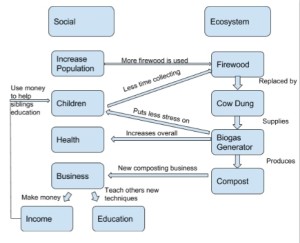The core ideas behind my diagram is that is simple but it displays how human ecology is present in India. Human ecology is the relationship between the people and the ecosystem and the impact they have on each other. My diagram begins with the increasing population in India. This results in an overall decrease in wood that once fueled the fires in homes. A new idea was formulated, which is known as the Biogas Generator. It is fueled by cow dung and it replaces firewood. Children were once spending much of their day retrieving firewood for their mothers and missing out on much school work. This new advancement allow them to focus on school and the family will still have easy access to fire. The remains of the generator is mixed with worms and different material results in compost. They are making a business out of it by educating others of their new ideas, as well as making a profit to support the family. The older siblings and mothers said that this money is used to help the young children to get educated. The structure of my diagram is very similar and it covers the same basic ideas as Gerry Marten’s figure. We both go into depth on how the generator is fueled but mine is different in the fact that I touch on the compost and how they use it as a way of making money. I found it very beneficial to compare diagrams at the end because it was a way to look at human ecology in a different perspective to see how they connected the social aspect and environment.
2 thoughts on “Module 2- Douglas Apple”
Leave a Reply
You must be logged in to post a comment.


Hey Doug, thanks for reading over and looking at my biogas diagram. You were right our two diagrams are very similar, yours is very well put together and easy to read! You have all the important parts from the short clip, and the process very well labelled and easy to interpret! Good work
Hi Douglas! I like how you included the aspects of business and income in your diagram. These are things that are important parts of society but aren’t always included when thinking about a social system. They are just as influential on people as the environment and should definitely be included. Comparing our diagrams, we both have a similar format on the ecosystem side of our diagrams but you also put a focus on business, income, and health while mine focuses on the environment’s impact on society. It’s nice to look at both of our diagrams and see the difference in perspective on human ecology in Karnataka, India.
If you have the chance, check out my blog post: http://geog030.dutton.psu.edu/2016/01/26/module-2-laura-young/